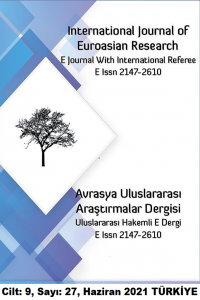Öz
nearly seventy years and showing the consequences and reflections of the political ideology it is
involved in as the product of a systematic mechanism, have been determined. In line with the
conclusions, it has been examined that these animated films form a kind of cultural memory that
reflects the political history and social culture of the Soviets. The content analysis method
proposed by Juliet Corbin and Anselm Strauss for the analysis of qualitative data was used in
the article. This method aims to gather and interpret similar data within the framework of specific
concepts and categories. Content analysis was created in four stages: a) coding of data, b)
finding categories, c) organizing codes and categories, d) defining and interpreting findings. If a
structure is formed in line with the decisions, it is perceived that two separate groups are
created as ‘we’ and ‘they’ in the films analyzed, and the expression ‘they’ is based on two
elements: anti-Westernism built in the context of capitalism and imperialism, and anti-Nazism
within the connection of fascism. The expression ‘we’ is based on bringing socialism and
communism to the forefront, spreading and rooting them. In this connection, it has been noticed
that the films used as data can be combined under three main titles: ‘Anti-Capitalist and AntiImperialist Films’, ‘Anti-Fascist Films’, and ‘Films with Praise for Socialism and Communism’.
After considering all the findings and inferences made, it was comprehended that the animated
films were documents that exhibit the period in which they were described or referenced. From
this point of view, it can be assumed that the propaganda actions carried out by the Soviet
Union not only ensure the development and persistence of existing political ideas and
ideologies but also found a cultural memory in the society.
Anahtar Kelimeler
Animation Cinema The Soviet Union Content Analysis Propaganda
Kaynakça
- BENDAZZI, Giannalberto, (1995), Cartoons: One Hundred Years of Cinema Animation, Indiana University Press.
- BORSTEN, Joan, (Director), (1997), The Animated Soviet Propaganda: From the October Revolution to Perestroika [DVD].
- EISENSTEIN, Sergei, (1982), Film Essays and a Lecture, New Jersey: Princeton University Press.
Ayrıntılar
| Birincil Dil | Türkçe |
|---|---|
| Bölüm | Makaleler |
| Yazarlar | |
| Yayımlanma Tarihi | 16 Haziran 2021 |
| Gönderilme Tarihi | 26 Ocak 2021 |
| Yayımlandığı Sayı | Yıl 2021 Cilt: 9 Sayı: 27 |
Avrasyad''de yayınlanan makaleler, Creative Commons Atıf-Gayriticari 4.0 Uluslararası Lisansı (CC BY-NC 4.0) ile lisanslanmıştır. Bilimsel araştırmaları kamuya ücretsiz sunmanın bilginin küresel paylaşımını artıracağı ilkesini benimseyen dergi, tüm içeriğine anında açık erişim sağlamaktadır. Makalelerdeki fikir ve görüşlerin sorumluluğu sadece yazarlarına ait olup Avrasyad''nin görüşlerini yansıtmazlar. Kullanım Şartları ve Gizlilik Politikası


